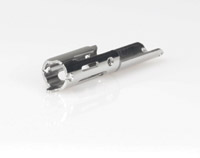
Posted to News on 25th May 2012, 00:00
From concept to production
The pace of product launch continues to pick up throughout every industry. To meet OEM requirements for this fast pace, engineering expertise is taking on an ever-more important role in the world of metal stamped parts and springs, argue Pete Marut and Dale Pereira.

>Original equipment manufacturers are pushing the envelope to get from concept to production in the fastest possible time. Expertise in prototyping parts to test and prove design concepts, suggesting ways to reduce secondary operations to reduce cost, and providing value engineering consulting expertise, are key engineering skills that ensure the success of projects. Behind it all is a foundation of communications and two-way dialogue that ensures that products meet customer requirements.
>The devil is in the detail, so no matter what the industry, or the schedule requirements, each project should begin by establishing lines of communication to get an in-depth understanding of a customer's design, objectives, and material requirements. A discussion of part dimension tolerance is essential. Some tight tolerances may add significant cost, and may not be critical, while others may be achievable at no additional cost. Understanding the key dimensions and the most critical part tolerances is extremely valuable to both parties when developing the final part print.
>Familiarising oneself with the product, including models and 3D drawings, and following that up by talking to the customer to get a clear idea of what is needed and identifying critical characteristics are the next important steps. These steps are followed by internal discussions to develop recommended options for design, tooling and production. At Connecticut Springs & Stamping (CSS), this initial phase set the scene for a successful project for Aragon Surgical, a California-based startup medical device firm that significantly reduced its costs by converting a fully machined part to a stamped part with machined features.
>Brandon Loudermilk, Aragon Surgical's senior research and development engineer, explains that he was looking to reduce the overall cost of the firm's previously released laparoscopic surgical device, and was given the task of finding ways to decrease costs on as many parts as possible. The jaw housing was one of the higher priced parts, making it a good candidate for alternatives. In addition, there were problems getting sufficient parts from the existing supplier.
>At the initial contact with Aragon Surgical, engineers at CSS began the process by looking at the part and discussing ways it might be stamped instead of machined from a solid tube. "When we started I thought there was no way anyone could stamp this part to be perfectly round and make it function properly," says Loudermilk. Engineers at CSS then hosted several conversations and went through numerous steps to arrive at the most important features on the part and figure out how it could be stamped within the necessary tolerances.
>One interesting aspect of the early conversations was that CSS engineers showed Aragon another piece they make, a lock barrel for a high end commercial door lock that was similar in many ways to the jaw housing. "When I saw how they could produce that part, how round it was and how good the finish was, it made me consider talking to them more about stamping this part."
>Once they started talking, CSS engineers went over the part print with a fine-toothed comb, adjusting the 3D CAD model and marking up the original drawing with their initial ideas. The groups discussed the tight dimensions, stepping through each feature to see if they could hold the tolerances, looking at the mating parts to see what the critical features were and how the mating parts interacted, discussing which features were critical and agreeing on which other features could be machined out, and how the part would have to be aligned. Many emails, redlined drawings, web meetings later, the agreement was made. And that was just the first phase.
>Significant cost savings
>The tooling costs were significant, but the high per part savings made the investment worth it. "We paid up front for a certain quantity of parts, with the additional cost going towards paying for the tool costs," says Loudermilk. "This enabled us to get cheaper parts quickly, without putting out our capital up front. After the initial run was consumed, the tooling comes out of the piece price, making it that much more attractive and profitable." Loudermilk estimates that the initial run was 20-30% cheaper; when the tooling costs come out the new stamped jaw housing is 50-60% cheaper than the machined version, while still meeting all the design specifications.
>One fact of life in the metal stamping and springs industry is that metal components are often the last to be sourced. Since plastic parts cannot be changed without significant mould costs and very long lead times, stamped metal parts and springs frequently need to adjust to other parts' restrictions. This makes prototyping a very important part of the design development process. Is raw material cost a main concern, or is tooling cost the biggest issue? Getting this information up front is essential to develop a prototype or series of prototypes to meet their needs. With a brand new product, enough detail is needed to work out the best material to make a prototype that can be manufactured in a production scenario.
>Tony Morefield, director of manufacturing and engineering services for California-based Avantis Medical Systems, used the prototyping phase to great advantage to develop a cost effective spring for a catheter, which is fitted on the end to lock the part into the working channel of a scope. Avantis had experienced quality issues with its original supplier and was looking for a spring that would perform well in the instrument. Spring tolerances were key; there were tight angles Avantis needed to be held for the spring to perform properly. As part of the research and development process for the part, CSS went through about four revisions where they tested slightly different angles and dimensions on the spring. "Actually, it's interesting, but at first I didn't even realise we were prototyping," says Morefield. "We received feedback from the original drawings that the engineers were not comfortable they could manufacture the part as designed. We revised the drawings live on conference calls and discussed the design to see where we had leeway as far as changing tolerances. This method was great for coming to an agreement quickly on what the next revision would look like."
>From CSS's perspective the Avantis process was different than many because Avantis came in with a design whose tolerances and bend angles made it extremely difficult to manufacture. Engineers made a few suggestions on the bend angles that connect two coiled sections of the spring. Opening up some tolerances to make the part manufacturable and supplying a prototype to try it out worked well. The result of the prototyping effort has been successful, says Morefield. "We have been through a lot of benchtop testing and have used the instrument on about 100 patients. We are now in the midst of a full commercial launch."
>Stamped metal and springs are used in millions of products across the gamut of industries. Experience on how metals move and where they are likely to fail goes a long way to reducing costs and developing solutions. In addition, experienced engineers can increase value and reduce costs by designing tooling with flexible options for change. This is frequently done by adding skip stations in a die for a nominal up front tool cost where additional cutting or forming can be added if needed.
>From the initial customer contact and quotation phase, to prototyping, to value engineering, production tooling, running parts off progressive tooling, and quality control and inspection, the metal springs and stamping business has had to adapt to this rapid pace. The examples of Aragon Surgical and Avantis Medical Systems among many others show that each step plays an important role in moving a part from concept to completion at the blazing speeds now considered normal.








